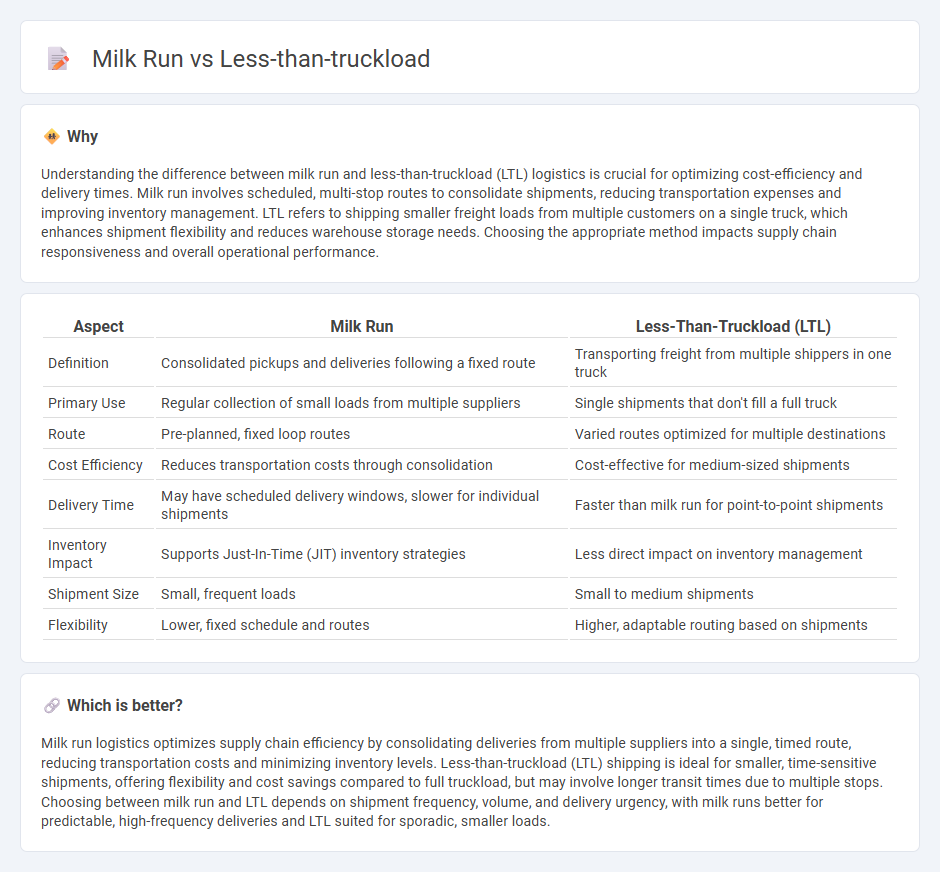
Milk run logistics optimizes supply chain efficiency by consolidating multiple small pickups and deliveries into a single route, reducing transportation costs and minimizing inventory levels. Less-than-truckload (LTL) shipping involves transporting smaller freight shipments that do not require a full truck, combining multiple shipments from different customers into one trailer to maximize carrier utilization. Discover the key differences and advantages of milk run versus LTL logistics to enhance your supply chain strategy.
Why it is important
Understanding the difference between milk run and less-than-truckload (LTL) logistics is crucial for optimizing cost-efficiency and delivery times. Milk run involves scheduled, multi-stop routes to consolidate shipments, reducing transportation expenses and improving inventory management. LTL refers to shipping smaller freight loads from multiple customers on a single truck, which enhances shipment flexibility and reduces warehouse storage needs. Choosing the appropriate method impacts supply chain responsiveness and overall operational performance.
Comparison Table
| Aspect | Milk Run | Less-Than-Truckload (LTL) |
|---|---|---|
| Definition | Consolidated pickups and deliveries following a fixed route | Transporting freight from multiple shippers in one truck |
| Primary Use | Regular collection of small loads from multiple suppliers | Single shipments that don't fill a full truck |
| Route | Pre-planned, fixed loop routes | Varied routes optimized for multiple destinations |
| Cost Efficiency | Reduces transportation costs through consolidation | Cost-effective for medium-sized shipments |
| Delivery Time | May have scheduled delivery windows, slower for individual shipments | Faster than milk run for point-to-point shipments |
| Inventory Impact | Supports Just-In-Time (JIT) inventory strategies | Less direct impact on inventory management |
| Shipment Size | Small, frequent loads | Small to medium shipments |
| Flexibility | Lower, fixed schedule and routes | Higher, adaptable routing based on shipments |
Which is better?
Milk run logistics optimizes supply chain efficiency by consolidating deliveries from multiple suppliers into a single, timed route, reducing transportation costs and minimizing inventory levels. Less-than-truckload (LTL) shipping is ideal for smaller, time-sensitive shipments, offering flexibility and cost savings compared to full truckload, but may involve longer transit times due to multiple stops. Choosing between milk run and LTL depends on shipment frequency, volume, and delivery urgency, with milk runs better for predictable, high-frequency deliveries and LTL suited for sporadic, smaller loads.
Connection
Milk run and less-than-truckload (LTL) logistics both focus on optimizing freight transportation by consolidating multiple shipments to improve efficiency and reduce costs. Milk run involves collecting goods from multiple suppliers in a single trip, which aligns with the LTL model of transporting smaller freight loads from various shippers together in one truck. This synergy minimizes transportation waste, enhances delivery frequency, and lowers overall logistics expenses in supply chain management.
Key Terms
Consolidation
Less-than-truckload (LTL) shipping consolidates multiple smaller shipments from various shippers into a single trailer to optimize costs and improve delivery efficiency. Milk run logistics streamline inbound or outbound freight by routing deliveries or pickups through multiple suppliers or customers in a single trip, minimizing empty miles and enhancing consolidation. Explore how strategic consolidation can drive cost savings and operational efficiency in your supply chain.
Routing
Less-than-truckload (LTL) shipping consolidates multiple small shipments from different customers into one truck, optimizing routes by leveraging freight density and minimizing empty miles. Milk run routing involves a fixed circuit where a single vehicle sequentially picks up or delivers goods from multiple suppliers or destinations, enhancing efficiency in repetitive, short-distance logistics. Explore deeper insights into how routing strategies impact supply chain performance and cost-effectiveness.
Freight Optimization
Less-than-truckload (LTL) shipping consolidates multiple shipments from different customers into a single truck, maximizing load efficiency and reducing individual shipping costs. Milk run logistics involves a fixed route where a single vehicle picks up or delivers goods from multiple suppliers or customers, optimizing route planning and minimizing empty miles. Explore the advantages of each method to enhance your freight optimization strategy and reduce overall transportation expenses.
Source and External Links
What Is Less-Than-Truckload (LTL)? - XPO - LTL shipping is used for freight that does not require a full truckload trailer, typically weighing between 500 and 15,000 pounds and shipped on pallets, with shipments consolidated and cross-docked through a hub-and-spoke network for efficient delivery.
Less-than-truckload shipping - Wikipedia - LTL refers to transportation of freight between individual parcels and full truckloads, handling shipments that are larger than parcels but not enough to fill a full semi-trailer, usually from about 150 pounds up to full trailer loads.
What is Less Than Truckload (LTL) Freight - Uber Freight - LTL is a cost-effective freight shipping method where shipments from multiple customers share space on one truck, each paying only for the portion of space their cargo uses, typically between 150 and 15,000 pounds, unlike full truckload shipping where one shipper rents the entire truck.
 dowidth.com
dowidth.com